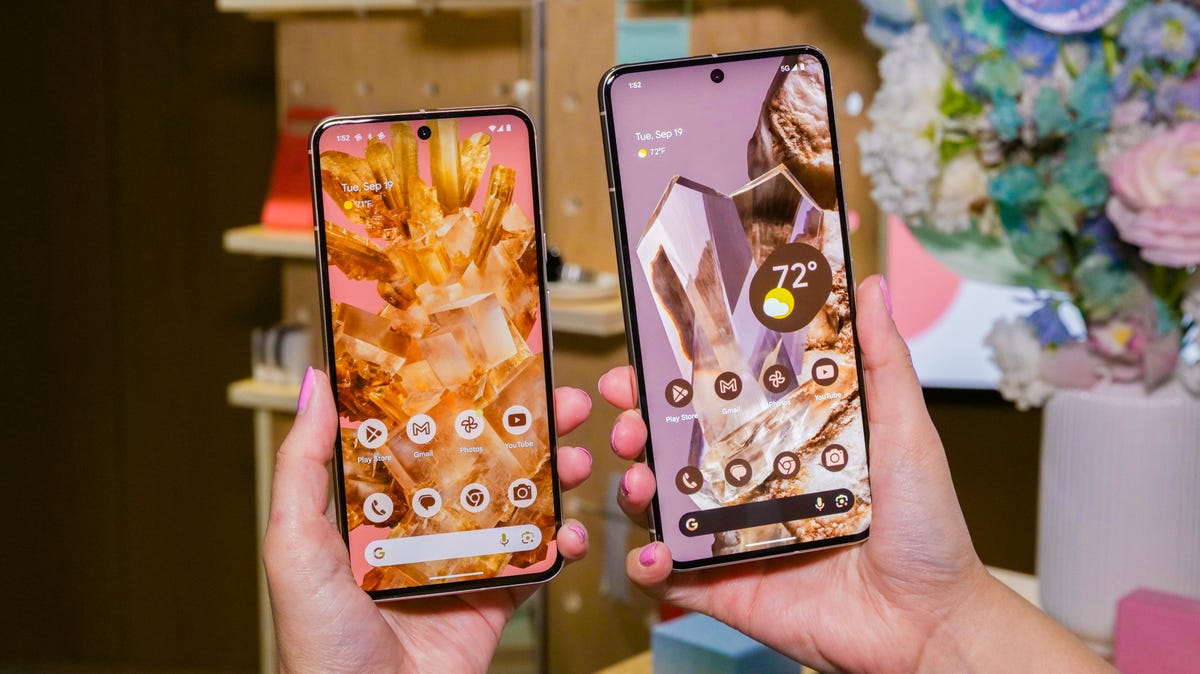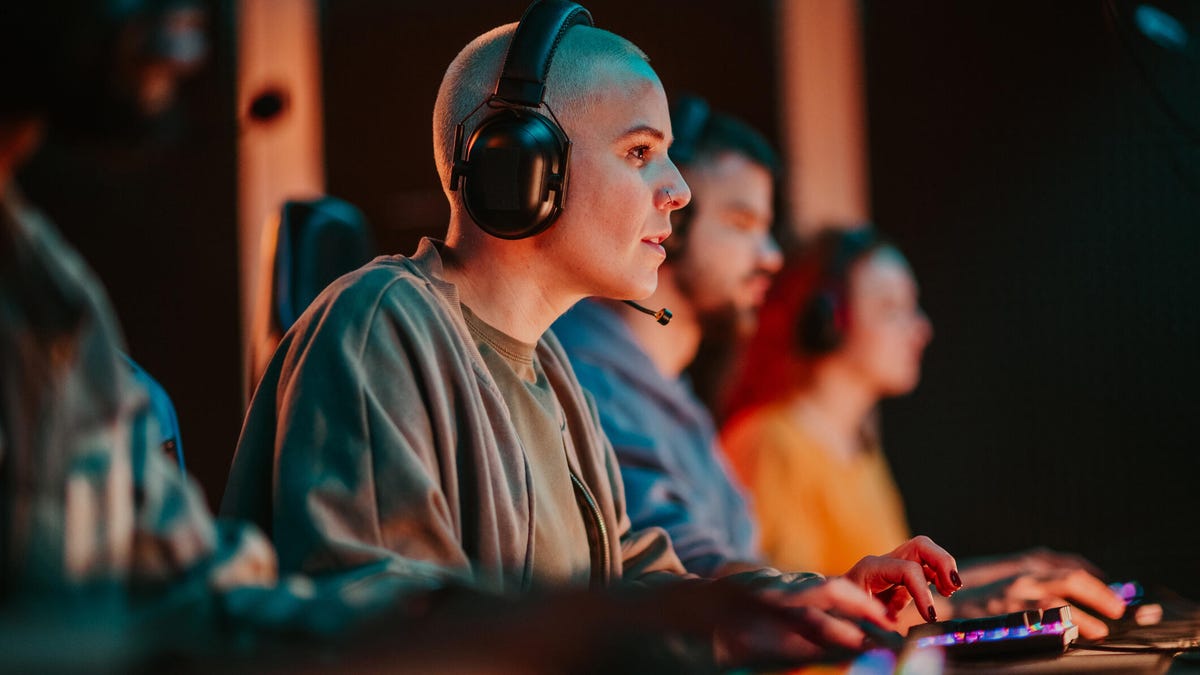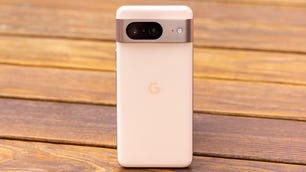Technologies
Google Pixel 8, Pixel 8 Pro, Watch 2: Everything Google Just Announced
«The most beautiful phones we’ve ever made.»
At Wednesday’s Made by Google event, the company launched its Pixel 8 and Pixel 8 Pro phones along with the Pixel Watch 2, to no one’s surprise — the world already knew a lot of the details thanks to information that dribbled out in the weeks leading up.
Like the other hardware-slash-operating system companies, Google highlighted the way its phones use new features in Android 14, which was announced at Google I/O in June, and becomes available with these phones when they ship by midmonth. Unsurprisingly, it concentrates on its AI-based software rather than the changes to the phone’s hardware over the Pixel 7 line, including updates to Google Assistant and new photo editing tools. There are some notable hardware updates, like the company’s new Tensor G3 AI-accelerator, improved screen brightness, a new temperature sensor and new cameras.
The Pixel Watch 2 also received some modest improvements, such as more accurate heart-rate sensing and updates to its safety features and more. Like Android, the Watch’s operating system, Wear OS 4, was announced at Google I/O and ships with the Watch at the same time as the phones.
Rick Osterloh, Google’s SVP for devices and services, breezed through some updates before he even got to the main products. The Pixel Buds Pro get upgraded with AI enhancements to sound quality, and use of Bluetooth Super Wide Band for more flexible, high-bandwidth sound. They have reduced latency, which is important for gaming. They’ll come in new colors to match the phones, bay blue and porcelain.
The Pixel Fold will be updated with Dual Screen translation, and its discussion of Google Home AI and Assistant updates, which will first launch as experiments — notably the future Google Assistant with Bard preview — sounded an awful lot like Amazon’s Alexa boosts.
Pixel support has been expanded to seven years of support and updates, as well.
Google Pixel 8 and Pixel 8 Pro phones
A lot remains the same for these phones relative to their predecessors, but there are a handful of hardware and software upgrades to increase their appeal. For instance, the screen sizes remain the same but they have improved the adaptive refresh rates’ range, which can let it drop very low when you don’t need the speed and make your battery happier. Google’s gone rounder with all the edges, which turns out to be calming. And new Actua and Super Actua displays on the Pixel and the Pro, respectively, deliver much brighter HDR peaks — 2,400 nits, for the Pro, which is high.

Both phones have main cameras with new dual-conversion gain sensors, a technology like that used by the Galaxy S23’s Isocell HP2 sensor, which lets it apply two different gain curves to the image — boosting and reducing noise in shadows and pulling back on areas with bright highlights — to generate a high dynamic range image in a single shot rather than merging a burst at different exposures.
They also have marginally higher resolution front cameras, but the Pro can autofocus.
Every AI demo we’ve seen in the past couple of years has shown itself off by summarizing web pages, and Google Assistant’s enhancement is no different. But its call spam filter, Call Screen, sounds more natural when it answers for you. It’s also designed to analyze voice-message context and widgetize it into actionable items — think getting various choices of an autoresponse to the food delivery person who’s dropping off dinner.
- Google Pixel 8 Cameras Supercharge Video to Lead Photography Upgrades
- Google Pixel 8 and 8 Pro Pack More AI and New Cameras, But at a Higher Price
- Google’s Pixel 8 Pro Has a Temperature Sensor. Here’s What It Does
- Best Pixel 8 and Pixel 8 Pro Preorder Deals: Free Pixel Watch 2 and More
- Google Pixel 8’s Audio Magic Eraser Silences Annoying Noise In Your Videos
A new Video Boost feature automatically retouches videos’ shadows and noise and applies digital image stabilization, but in the cloud rather than on your phone. Because a data center has a lot more processing power to efficiently work with the full-resolution file, which happens when the video syncs from your phone to the heavens. You see a lower-resolution (1080p) proxy on your phone until the video’s been completely processed and synced back. Additionally, Google’s bringing its low-light Night Sight image processing to video.
Google’s own camera app gets manual controls for shutter speed, exposure time (for timed shooting in extreme low light), white balance, ISO sensitivity and focus. There are also enhancements to some photo file formats in the form of more metadata for color management (like Adobe DNG) and to properly display photos on other devices (Ultra HDR).
Additionally, there are a handful of new or improved «magic» and AI-boosted features, such as Best Take. It lets you merge selected faces in a group show to create a single version in which everyone’s got their best face on — or worst, if that’s the way you roll. Audio Magic Eraser can theoretically distinguish and filter out particular sounds.
The Pixel 8 Pro distinguishes itself from the plain ol’ Pixel 8 in a few ways. It’s still larger (6.7 inches to the Pixel’s 6.2) and has a marginally higher capacity battery with a concomitant marginal increase in weight of 1 gram.
It’s also the first Google device to be able to run some lighter weight generative AI operations, such as a more fine tuned Magic Eraser, thanks to in-phone AI foundation models (the code that’s essential to run them locally).
One big add to the Pro’s hardware is a temperature sensor to measure the heat coming off items, for instance to tell you if they’re exceptionally hot or cold — that could be a boon to people with temperature-sensitive teeth… I guess? Well, it’s not the most crowd-pleasing sensor, at least until Food and Drug Administration approval comes through to let Google use it for measuring body temperature. I would actually find this useful to measure how hot a laptop gets — if only to confirm I’m not imagining things.
It also has a 48-megapixel ultrawide camera with a new sensor that’s more sensitive than the older 12-megapixel version; it’s got a wider aperture lens to let in more light. Plus, it can now autofocus and shortens the macro focus distance by about 1cm.
The Pixel 8 Pro starts at $999 (£999, AU$1,699) and the Pixel 8 at $699 (£699, AU$1,199). Both start shipping on Oct. 12 and are available to preorder now.
Google Pixel Watch 2
The second generation of Google’s wrist wearable integrates some Fitbit Sense 2 capabilities, like automatically starting and stopping workouts, which the Apple Watch has had for a while, plus adds sensors for detecting temperature and stress indicators.
- Google Pixel Watch 2 Should Solve the First One’s Biggest Shortcomings
- Fitbit Will Use AI to Connect the Dots Between Your Health Metrics
Other new features include a better heart rate sensor that collects data from multiple contact points (it claims up to 40% more accurate tracking at high altitude), and improved training tools that incorporate the new data. Plus there’s a processor upgrade for improved performance (the watch, not you) — faster processor, faster charge, «all day» battery — and new safety features. One example of the latter is Safety Check, the equivalent of «if you don’t hear from me in an hour, call the police.» There’s also real-time emergency location sharing.
It’s more durable, with better cover glass and tweaks to some of the band design aspects.
It ships on Oct. 12 for $350 (£349, AU$549); preorders start today.
Technologies
If You Were ‘Tricked’ Into an Amazon Prime Subscription, You Should Have Been Paid by Today
Amazon is paying $1.5 billion to people who mistakenly subscribed to Prime, and the first round of payments are due today.

Amazon Prime provides a lot of valuable benefits to its members, but the company’s registration practices for its premium subscription from 2019 to 2025 led to many customers accidentally subscribing to a service they didn’t want.
Amazon is now paying the price for that deception — the US Federal Trade Commission levied a massive $2.5 billion settlement on the company for its subscription tactics.
The majority of the settlement — $1.5 billion — has been earmarked to refund eligible subscribers, with the rest serving as a civil penalty. Amazon is also now legally required to provide a clear, obvious option to decline Prime, making it as easy to leave the service as it is to join.
Amazon isn’t admitting to shady behavior. «Amazon and our executives have always followed the law, and this settlement allows us to move forward and focus on innovating for customers,» Mark Blafkin, Amazon senior manager, said in a statement. «We work incredibly hard to make it clear and simple for customers to both sign up or cancel their Prime membership, and to offer substantial value for our many millions of loyal Prime members around the world.»
The online retail giant started sending out payments to eligible people in November and was supposed to conclude its initial automatic payments today, Dec. 24. Read on to learn more about Amazon’s settlement and what to do if you think you’re eligible for compensation but didn’t receive a payment.
Why did the FTC fine Amazon?
The FTC filed suit against Amazon, accusing the company of using «dark patterns» to nudge people into Prime subscriptions and then making it too hard to cancel. The FTC maintained Amazon was in violation of Section 5 of the FTC Act and the Restore Online Shoppers’ Confidence Act.
«Specifically, Amazon used manipulative, coercive or deceptive user-interface designs known as ‘dark patterns’ to trick consumers into enrolling in automatically renewing Prime subscriptions,» the FTC complaint stated.
Who’s eligible for Amazon’s payout?
Amazon’s legal settlement is limited to customers who enrolled in Amazon Prime between June 23, 2019, and June 23, 2025. It’s also restricted to customers who subscribed to Prime using a «challenged enrollment flow» or who enrolled in Prime through any method but were unsuccessful in canceling their memberships.
The FTC called out specific enrollment pages, including Prime Video enrollment, the Universal Prime Decision page, the Shipping Option Select page and the Single Page Checkout. To qualify for a payout, claimants must also not have used more than 10 Amazon Prime benefits in any 12-month period.
Customers who signed up via those challenged processes and did not use more than three Prime benefits within one year will be paid automatically by Amazon within 90 days. Other eligible Amazon customers will need to file a claim, and Amazon is required to send notices to those people within 30 days of making its automatic payments.
If you are eligible for the automatic payment, you should have received an email from Amazon by today explaining how to claim the money. You can be paid via PayPal or Venmo. If you prefer a paper check, don’t accept the digital payment. The FTC says Amazon will mail you a check that you must cash within 60 days.
How big will the Amazon payments be?
Payouts to eligible Amazon claimants will be limited to a maximum of $51. That amount could be reduced depending on the number of Amazon Prime benefits you used while subscribed to the service. Those benefits include free two-day shipping, watching shows or movies on Prime Video or Whole Foods grocery discounts.
Customers who qualify for the payments should have received them from Nov. 12 to Dec. 24, 2025.If you are eligible for compensation from Amazon but didn’t receive a payout, you’ll need to file a claim after Amazon starts the claim process. The FTC says it will update its Amazon settlement site once that process has begun.
Customers who did not use a challenged sign-up process but instead were unable to cancel their Prime memberships will also need to file claims for payment.
Technologies
Today’s NYT Connections: Sports Edition Hints and Answers for Dec. 25, #458
Here are hints and the answers for the NYT Connections: Sports Edition puzzle for Dec. 25, No. 458.

Looking for the most recent regular Connections answers? Click here for today’s Connections hints, as well as our daily answers and hints for The New York Times Mini Crossword, Wordle and Strands puzzles.
Today’s Connections: Sports Edition has a real mix of categories, including one that’s all about a certain famous athlete. If you’re struggling with today’s puzzle but still want to solve it, read on for hints and the answers.
Connections: Sports Edition is published by The Athletic, the subscription-based sports journalism site owned by The Times. It doesn’t appear in the NYT Games app, but it does in The Athletic’s app. Or you can play it for free online.
Read more: NYT Connections: Sports Edition Puzzle Comes Out of Beta
Hints for today’s Connections: Sports Edition groups
Here are four hints for the groupings in today’s Connections: Sports Edition puzzle, ranked from the easiest yellow group to the tough (and sometimes bizarre) purple group.
Yellow group hint: Swing away!
Green group hint: What’s that on your bat?
Blue group hint: Catch the football.
Purple group hint: Lake Placid or Lillehammer.
Answers for today’s Connections: Sports Edition groups
Yellow group: Baseball bat materials.
Green group: Associated with George Brett.
Blue group: NFL rookie WRs.
Purple group: Olympic ____.
Read more: Wordle Cheat Sheet: Here Are the Most Popular Letters Used in English Words
What are today’s Connections: Sports Edition answers?
The yellow words in today’s Connections
The theme is baseball bat materials. The four answers are aluminum, ash, birch and maple.
The green words in today’s Connections
The theme is associated with George Brett. The four answers are 5, pine tar, Royals and third base.
The blue words in today’s Connections
The theme is NFL rookie WRs. The four answers are Burden, Egbuka, Golden and McMillan.
The purple words in today’s Connections
The theme is Olympic ____. The four answers are Games, rings, torch and village.
Don’t miss any of our unbiased tech content and lab-based reviews. Add CNET as a preferred Google source.
Technologies
Christmas Eve Gaming Crushed as Steam Goes Offline
Services related to the popular game hub seem to slowly be returning as of Wednesday afternoon.

Your Christmas Eve gaming session might not go as planned. Online gaming hub Steam went down on Wednesday. As of about 1:30 pm PT, the Steam store page was once again accessible, so services seemed to be coming back online.
The Steam outage appeared to begin mid-afternoon ET, according to Downdetector, which monitors site outages. (Disclosure: Downdetector is owned by the same parent company as CNET, Ziff Davis.)
A representative for Steam did not immediately respond to a request for comment.
As of Wednesday noon PT, Steam’s official X and Bluesky accounts hadn’t posted anything about the outage.
Gamers certainly noticed. «Steam down, Steam down!!!» wrote one Bluesky user.
Others commented on the bad timing just as gamers were enjoying time off or receiving gaming gifts. «‘You got a gift on Steam!’ oh cool ‘Steam is down’ oh cool,» wrote another Bluesky user.
-

 Technologies3 года ago
Technologies3 года agoTech Companies Need to Be Held Accountable for Security, Experts Say
-

 Technologies3 года ago
Technologies3 года agoBest Handheld Game Console in 2023
-

 Technologies3 года ago
Technologies3 года agoTighten Up Your VR Game With the Best Head Straps for Quest 2
-

 Technologies4 года ago
Technologies4 года agoBlack Friday 2021: The best deals on TVs, headphones, kitchenware, and more
-

 Technologies4 года ago
Technologies4 года agoVerum, Wickr and Threema: next generation secured messengers
-

 Technologies4 года ago
Technologies4 года agoGoogle to require vaccinations as Silicon Valley rethinks return-to-office policies
-

 Technologies4 года ago
Technologies4 года agoOlivia Harlan Dekker for Verum Messenger
-

 Technologies4 года ago
Technologies4 года agoiPhone 13 event: How to watch Apple’s big announcement tomorrow



